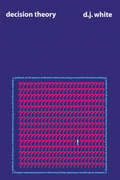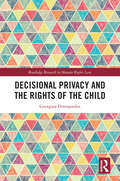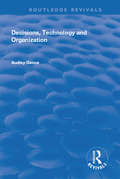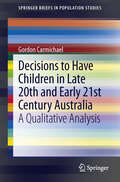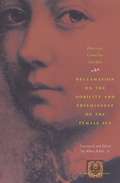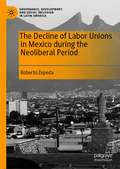- Table View
- List View
Decision Science (Routledge Revivals)
by Ann Van Ackere Kiriakos VlahosThis title was first published in 2000. This text is part of the "International Library of Management", which aims to present a comprehensive core reference series comprised of significant and influencial articles by the authorities in the management studies field. The collection of essays is both international and interdisciplinary in scope and aims to provide an entry point for investigating the myriad of study within the discipline.
Decision Support for Forest Management: (pdf) (Managing Forest Ecosystems #16)
by Annika Kangas Jyrki Kangas Mikko KurttilaDecision Table Languages and Systems
by John R. Metzner Bruce H. BarnesACM Monograph Series: Decision Table Languages and Systems focuses on linguistic examination of decision tables and survey of the features of existing decision table languages and systems. The book first offers information on semiotics, programming language features, and generalization. Discussions focus on semantic broadening, outer language enrichments, generalization of syntax, limitations, implementation improvements, syntactic and semantic features, decision table syntax, semantics of decision table languages, and decision table programming languages. The text then elaborates on design implications, decision structure tables, spectrum of decision table use, and history of decision table programming. Topics include feature evaluation method, breadth of decision table applicability, and suggested design procedure. The book also takes a look at sequential test procedures and language references. The publication is a vital reference for researchers interested in decision table languages and systems.
Decision Theory
by D.J. WhiteAll of human life may be seen as a process of decision-making, but it is only in recent years and in response to the needs of the large and complex organizations characterizing our society that this process has been subjected to scientifi c scrutiny. Out of this scrutiny-undertaken by a wide range of professionals in economics, administration, management, statistics, psychology, engineering, computer science, operations research, and systems analysis-there has begun to emerge a body of theory that has profound implications for improving practical decision-making. This book is the fi rst to bring together all the various aspects of decision theory into one cohesive treatment.
Decision Theory
by D.J. WhiteAll of human life may be seen as a process of decision-making, but it is only in recent years and in response to the needs of the large and complex organizations characterizing our society that this process has been subjected to scientifi c scrutiny. Out of this scrutiny-undertaken by a wide range of professionals in economics, administration, management, statistics, psychology, engineering, computer science, operations research, and systems analysis-there has begun to emerge a body of theory that has profound implications for improving practical decision-making. This book is the fi rst to bring together all the various aspects of decision theory into one cohesive treatment.
Decision Theory and Social Ethics: Issues in Social Choice (Theory and Decision Library #17)
by H. W. Gottinger W. LeinfellnerEthics, as one of the most respectable disciplines of philosophy, has undergone a drastic and revolutionary change in recent time. There are three main trends of this development. The first trend can be described as a tendency towards a rigorous formal and analytical language. This means simply that ethics has created beside its own formalized set theoretical language a variety of new formalized, logical and mathemati cal methods and concepts. Thus ethics has become a formalized meta or epidiscipline which is going to replace the traditional concepts, principles and ethical methods in the realm of social sciences. It is clear that a formalized form of ethics can be used more easily in social, economic and political theories if there are ethical conflicts to be solved. This first trend can be regarded as a conditio sine qua non for application in, and imposing ethical solutions on, social scientific theories. The second trend may be characterized as an association- or unification-tendency of a formalized and analytical ethics with decision theory. Decision theory as a new interdiscipline of social sciences is actually an assemblage of a variety of subtheories such as value-utility theory, game theory, collective decision theory, etc. Harsanyi has called this complex of subtheories a general theory of human behavior. Analytical or formal ethics is actually using this general theory of human behavior as a vehicle simply because this theory deals from the beginning with conflict solution, i. e.
Decisional Privacy and the Rights of the Child (Routledge Research in Human Rights Law)
by Georgina DimopoulosDecisional privacy gives individuals the freedom to act and make decisions about how they live their lives, without unjustifiable interference from other individuals or the state. This book advances a theory of a child’s right to decisional privacy. It draws on the framework of the United Nations Convention on the Rights of the Child and extends the work of respected children’s rights scholars to address a significant gap in understanding the interconnections between privacy, family law and children’s rights. It contextualises the theory through a case study: judicial proceedings concerning medical treatment for children experiencing gender dysphoria. This work argues that recognising a substantive right to decisional privacy for children requires procedural rights that facilitate children’s meaningful participation in decision-making about their best interests. It also argues that, as courts have increasingly encroached upon decision-making regarding children’s medical treatment, they have denied the decisional privacy rights of transgender and gender diverse children. This book will benefit researchers, students, judicial officers and practitioners in various jurisdictions worldwide grappling with the tensions between children’s rights, parental responsibilities and state duties in relation to children’s best interests, and with the challenge of better enabling and listening to children’s voices in decision-making processes.
Decisional Privacy and the Rights of the Child (Routledge Research in Human Rights Law)
by Georgina DimopoulosDecisional privacy gives individuals the freedom to act and make decisions about how they live their lives, without unjustifiable interference from other individuals or the state. This book advances a theory of a child’s right to decisional privacy. It draws on the framework of the United Nations Convention on the Rights of the Child and extends the work of respected children’s rights scholars to address a significant gap in understanding the interconnections between privacy, family law and children’s rights. It contextualises the theory through a case study: judicial proceedings concerning medical treatment for children experiencing gender dysphoria. This work argues that recognising a substantive right to decisional privacy for children requires procedural rights that facilitate children’s meaningful participation in decision-making about their best interests. It also argues that, as courts have increasingly encroached upon decision-making regarding children’s medical treatment, they have denied the decisional privacy rights of transgender and gender diverse children. This book will benefit researchers, students, judicial officers and practitioners in various jurisdictions worldwide grappling with the tensions between children’s rights, parental responsibilities and state duties in relation to children’s best interests, and with the challenge of better enabling and listening to children’s voices in decision-making processes.
Decisions of International Courts and Tribunals and International Arbitrations
by Rudolf BernhardtEncyclopedia of Public International Law, 2: Decisions of International Courts and Tribunals and International Arbitrations focuses on articles on cases of major importance in international law that have come before international courts and arbitral tribunals. The publication first elaborates on the Abu Dhabi Oil Arbitration, Acquisition of Polish Nationality, Admission of a State to Membership in United Nations, Aramco Arbitration, Argentina-Chile Frontier Case, and Arbitration Award under the Treaty of Finance and Compensation of 1961. The text then takes a look at the Barcelona Traction Case, Buraimi Oasis Dispute, Certain Expenses of the United Nations, Clipperton Island Arbitration, Costa Rica Packet Arbitration, and Customs Regime between Germany and Austria. The manuscript examines the Tinoco Concessions Arbitration, Timor Island Arbitration, Sovereignty over Certain Frontier Land Case (Belgium/Netherlands), Sapphire Arbitration, Railway Traffic between Lithuania and Poland, Preferential Claims against Venezuela Arbitration, and Pious Fund Arbitration. The publication is a dependable source of data for researchers interested in the decisions of international courts and tribunals and international arbitrations.
Decisions, Technology and Organization
by Audley GenusThis title was first published in 2000. This text analyzes the problems of managing large-scale technology projects. It addresses the contrast between projects' hoped-for benefits and the optimism with which they are promoted, and the high human, economic or environmental costs of their operation. The book is multi-disciplinary in its approach and an integration of different levels of analysis. It contains case studies that are analyzed in terms of the literatures on decision theory, public administration and strategic and project managment.
Decisions, Technology and Organization
by Audley GenusThis title was first published in 2000. This text analyzes the problems of managing large-scale technology projects. It addresses the contrast between projects' hoped-for benefits and the optimism with which they are promoted, and the high human, economic or environmental costs of their operation. The book is multi-disciplinary in its approach and an integration of different levels of analysis. It contains case studies that are analyzed in terms of the literatures on decision theory, public administration and strategic and project managment.
Decisions to Have Children in Late 20th and Early 21st Century Australia: A Qualitative Analysis (SpringerBriefs in Population Studies)
by Gordon CarmichaelThis book explores the process of decision-making around having children in a sample of 115 men, women and couples for whom family formation was a recent past, current or imminent future issue. The discussion is initially focused on the extent to which parenthood was contemplated in late adolescence and during the relationship formation/courtship process, and the process by which family sizes are determined. Decision-making associated with having first, second, third and fourth children is then examined in chapters entitled The First Child; The ‘Obligatory’ Second Child; The Discretionary Third Child and Fourth Children – Negative Reactions, Practical Issues. Decisions to Have Children in Late 20th and Early 21st Century Australia offers a detailed coverage of a topic with resonances and implications that apply to contemporary cultures all around the world.
Decisions, Values and Groups: Reports from the First Interdisciplinary Conference in the Behavioral Science Division Held at the University of New Mexico
by Dorthy WillnerDecisions, Values and Groups, Volume 1 contains the proceedings of the First Interdisciplinary Conference of the Behavioral Sciences Division of the Air Force Office of Scientific Research, held at the University of New Mexico in 1957. The papers explore the roles of decisions, values, and groups in the behavioral sciences and cover topics ranging from the use of mathematical models in decision making to the contribution of the laboratory to the study of individual differences. Theoretical contributions to small group research are also discussed. This book is comprised of 22 chapters and begins with an overview of the merging of mathematical and statistical techniques with the empirical method in the study of behavior, as well as the place of decisions, values, and groups in behavioral science research. The reader is then introduced to the applications of mathematical models to decision processes, with particular reference to the automation of decision making. The following chapters focus on conceptualizations and designs for research in values and evaluative processes; theoretical aspects of small group research; and psychodynamic patterns of behavior; and special problems in the military. A non-introspective approach to the study of human motivation is described. This volume will be of interest to behavioral scientists and social scientists.
Declamation on the Nobility and Preeminence of the Female Sex (The Other Voice in Early Modern Europe)
by Henricus Cornelius AgrippaOriginally published in 1529, the Declamation on the Preeminence and Nobility of the Female Sex argues that women are more than equal to men in all things that really matter, including the public spheres from which they had long been excluded. Rather than directly refuting prevailing wisdom, Agrippa uses women's superiority as a rhetorical device and overturns the misogynistic interpretations of the female body in Greek medicine, in the Bible, in Roman and canon law, in theology and moral philosophy, and in politics. He raised the question of why women were excluded and provided answers based not on sex but on social conditioning, education, and the prejudices of their more powerful oppressors. His declamation, disseminated through the printing press, illustrated the power of that new medium, soon to be used to generate a larger reformation of religion.
Declamation on the Nobility and Preeminence of the Female Sex (The Other Voice in Early Modern Europe)
by Henricus Cornelius AgrippaOriginally published in 1529, the Declamation on the Preeminence and Nobility of the Female Sex argues that women are more than equal to men in all things that really matter, including the public spheres from which they had long been excluded. Rather than directly refuting prevailing wisdom, Agrippa uses women's superiority as a rhetorical device and overturns the misogynistic interpretations of the female body in Greek medicine, in the Bible, in Roman and canon law, in theology and moral philosophy, and in politics. He raised the question of why women were excluded and provided answers based not on sex but on social conditioning, education, and the prejudices of their more powerful oppressors. His declamation, disseminated through the printing press, illustrated the power of that new medium, soon to be used to generate a larger reformation of religion.
Declamation on the Nobility and Preeminence of the Female Sex (The Other Voice in Early Modern Europe)
by Henricus Cornelius AgrippaOriginally published in 1529, the Declamation on the Preeminence and Nobility of the Female Sex argues that women are more than equal to men in all things that really matter, including the public spheres from which they had long been excluded. Rather than directly refuting prevailing wisdom, Agrippa uses women's superiority as a rhetorical device and overturns the misogynistic interpretations of the female body in Greek medicine, in the Bible, in Roman and canon law, in theology and moral philosophy, and in politics. He raised the question of why women were excluded and provided answers based not on sex but on social conditioning, education, and the prejudices of their more powerful oppressors. His declamation, disseminated through the printing press, illustrated the power of that new medium, soon to be used to generate a larger reformation of religion.
The Declaration of Arbroath: 'For Freedom Alone'
by Edward J. CowanThe Declaration of Arbroath, 6 April, 1320, is one of the most remarkable documents to have been produced anywhere in medieval Europe. Signed by 51 Scottish nobles, it confirms Scotland’s status as an independent sovereign state with the right to use military action if unjustly attacked.Quoted by many, understood by few, its historical significance has now almost been overtaken by its mythic status. Since 1998, the US Senate has claimed that the American Declaration of Independence is modelled upon ‘the inspirational document’ of Arbroath. This is the first book-length study to examine the origins of the Declaration and the ideas upon which it drew, while tracing the rise of its mythic status in Scotland and exploring its impact upon revolutionary America.
The Declaration of the Rights of Women: The Originial Manifesto for Justice, Equality and Freedom
by Olympe de GougesOlympe de Gouges was the most important fighter for women's rights you've never heard of. An activist and writer in revolutionary Paris, she published 'The Declaration of the Rights of Women' in 1791, and was beheaded two years later, her articulate demands for equality proving too much for their time.Over one hundred and fifty years later, the key statements of her declaration were internationally endorsed by the United Nations in its Declaration on the Elimination of Discrimination Against Women, which in turn went on to be legally recognized by nearly every country in the world. This volume presents both of these key texts along with enlightening and inspiring commentary from a host of powerful women, from Virginia Woolf to Hillary Clinton.
Decline and Prosper!: Changing Global Birth Rates and the Advantages of Fewer Children
by Vegard SkirbekkGlobally, women are having half as many children as they had just fifty years ago. Why have birth rates fallen, and how will low fertility affect our shared future? In Decline and Prosper!, demographic expert Vegard Skirbekk offers readers an accessible, comprehensive and evidence-based overview of human reproduction. Readers learn about the evolution of childbearing across different populations and how fertility is related to (changes in) our reproductive capacity, contraception, education, religion, partnering, policies, economics, assisted reproduction, and catastrophes. Readers will explore the future of family size and its impact on human welfare, women’s empowerment and the environment. Skirbekk argues that low fertility is on the whole a good thing, while recognizing the challenges of population aging and “coincidental” childlessness. A balanced, integrative examination of one of the most important issues of our time, Decline and Prosper! drives home the fact that we must ultimately adapt to a world with fewer children. The book will be invaluable to anyone who is interested in the far-reaching effects of global fertility, including researchers and students of demography, social statistics, medical sociologists, family and childhood studies, human geographers, sociology of culture, social and public policy.
The Decline of Arab Unity: The Rise and Fall of the United Arab Republic
by Elie PodehThis is the first book in English to tell the story of this important, yet neglected, episode in modern Arab history. The research is based on archival material located in the United States, Britain, Canada and Israel, as well as available resources in Arabic. The use of these primary sources allows for a fresh look at the UAR.
The Decline of Democracy in Turkey: A Comparative Study of Hegemonic Party Rule (Routledge Studies in Middle Eastern Politics)
by Kürşat ÇınarThis book explores the roots of the decline of democracy and the rise of hegemonic parties in Turkey, by comparing the Justice and Development Party (AKP) with other comparable cases throughout the world. Offering a novel analysis in the rise of hegemonic parties, this book incorporates the analysis of state-society relations and institutionalist approaches. A hegemonic party is a single political party that dominates the scene in multi-party elections for extended periods of time. Focusing on the cases of Turkey, Azerbaijan, Malaysia, Russia and other countries through the Middle East, Asia, Latin America, Africa and Europe, the book proves that hegemony building is possible through the combination of societal and institutional factors at the individual, local, and national levels. Multilingual comparative content analysis, rigorous statistical tests, and in-depth elite-level interviews support this theory, based on an extensive fieldwork analysis. Analysing contemporary as well as historical cases of hegemonic parties, the volume will be of interest to researchers and students in a broad range of areas including democratization, political parties and Turkish politics.
The Decline of Democracy in Turkey: A Comparative Study of Hegemonic Party Rule (Routledge Studies in Middle Eastern Politics)
by Kürşat ÇınarThis book explores the roots of the decline of democracy and the rise of hegemonic parties in Turkey, by comparing the Justice and Development Party (AKP) with other comparable cases throughout the world. Offering a novel analysis in the rise of hegemonic parties, this book incorporates the analysis of state-society relations and institutionalist approaches. A hegemonic party is a single political party that dominates the scene in multi-party elections for extended periods of time. Focusing on the cases of Turkey, Azerbaijan, Malaysia, Russia and other countries through the Middle East, Asia, Latin America, Africa and Europe, the book proves that hegemony building is possible through the combination of societal and institutional factors at the individual, local, and national levels. Multilingual comparative content analysis, rigorous statistical tests, and in-depth elite-level interviews support this theory, based on an extensive fieldwork analysis. Analysing contemporary as well as historical cases of hegemonic parties, the volume will be of interest to researchers and students in a broad range of areas including democratization, political parties and Turkish politics.
The Decline of Fertility in Europe
by Ansley Johnson Coale Susan Cotts WatkinsThis volume summarizes the major findings of the Princeton European Fertility Project. The Project, begun in 1963, was a response to the realization that one of the great social revolutions of the last century, the remarkable decline in marital fertility in Europe, was still poorly understood.Originally published in 1986.The Princeton Legacy Library uses the latest print-on-demand technology to again make available previously out-of-print books from the distinguished backlist of Princeton University Press. These editions preserve the original texts of these important books while presenting them in durable paperback and hardcover editions. The goal of the Princeton Legacy Library is to vastly increase access to the rich scholarly heritage found in the thousands of books published by Princeton University Press since its founding in 1905.
The Decline of Labor Unions in Mexico during the Neoliberal Period (Governance, Development, and Social Inclusion in Latin America)
by Roberto ZepedaThis book examines the most significant factors accounting for the decline of union density during the neoliberal period, focusing on the case of Mexico. Union density, which reflects the representation of labor unions in the employed labor force, is one of the main indicators of union strength. The relation of organized labor with the state and the political system are also considered. The analysis is framed within a structure concentrated on cyclical, structural and political-institutional factors linked to labor union performance. Over the last decades, the transformations brought about by neoliberalism and democratization reshaped many features of the domestic political and economic model in Mexico. Therefore, an examination of these developments regarding the repercussions of the factors linked to union density decline is crucial.
The Decline of Marriage in Namibia: Kinship and Social Class in a Rural Community (Kultur und soziale Praxis)
by Julia PauliIn Southern Africa, marriage used to be widespread and common. However, over the past decades marriage rates have declined significantly. Julia Pauli explores the meaning of marriage when only few marry. Although marriage rates have dropped sharply, the value of weddings and marriages has not. To marry has become an indicator of upper-class status that less affluent people aspire to. Using the appropriation of marriage by a rural Namibian elite as a case study, the book tells the entwined stories of class formation and marriage decline in post-apartheid Namibia.



